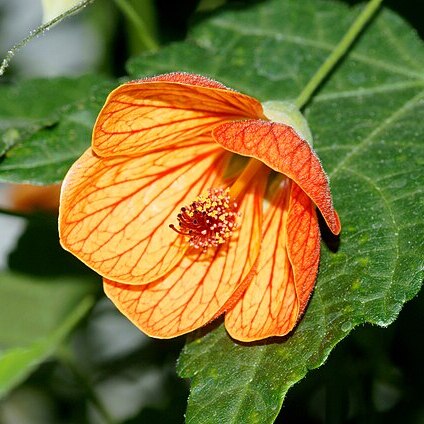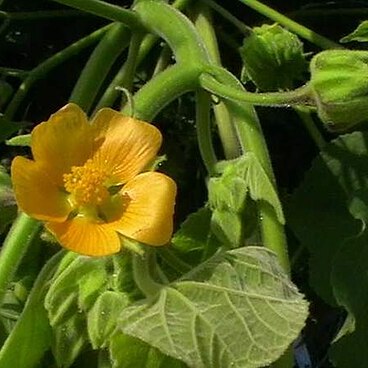Subshrubs, shrubs, or herbs. Stems erect, sometimes trailing (A. parvulum) or procumbent or ascending (A. wrightii), glabrescent or pubescent, sometimes viscid (A. hirtum, A. reventum, A. trisulcatum). Leaves: stipules usually persistent, subulate, lanceolate, or filiform; blade elliptic, ovate, [cordiform], sometimes shallowly lobed, but not maplelike [sometimes [sometimes umbellate]; involucel absent. Flowers: calyx not accrescent (except A. hulseanum, A. hypoleucum, A. palmeri, and A. wrightii), not inflated, not completely enclosing fruit, lobes not ribbed, lanceolate, ovate, cordate, or acuminate; corolla usually yellow or orange, less often pinkish, sometimes with dark red center; staminal column included or exserted; ovules 3(–6) per carpel; style 5–25-branched; stigmas sometimes black, capitate. Fruits schizocarps, erect, not inflated, globose, ovoid, oblate, cask-shaped, or cylindric, usually not indurate, variably hairy but not setose; mericarps 5–25, 1-celled follicle, adherent to adjacent mericarps and persistent on their axes, without dorsal spur, apex usually acute or acuminate to spinescent, sometimes rounded or obtuse, abaxially dehiscent. Seeds usually 3–6 per mericarp, usually turbinate, puberulent or scabridulous. x = 7, 8.
Herbs, subshrubs, shrubs, or small trees. Stipules usually caducous; leaf blade usually entire (lobed in A. pictum), palmately veined, base cordate, margin crenate or serrate. Flowers axillary or subterminal, solitary, paired or in small cymes, often aggregated into terminal panicles. Epicalyx absent. Calyx campanulate, lobes 5. Corolla mostly yellow or orange (red in A. roseum), often with dark center, campanulate to wheel-shaped, rarely ± tubular (A. pictum); petals 5, basally connate and adnate to filament tube. Anthers many, clustered at filament tube apex. Ovary (5-)7-20-loculed; ovules 2-9 per carpel; style branches as many as carpels. Fruit a schizocarp, often blackish when mature, subglobose to hemispherical; mericarps (5-)7-20, eventually dehiscent, apex rounded or acute, sometimes 2-awned, pericarp leathery. Seeds reniform, glabrous or slightly pubescent.
Fruit subglobose or turbinate to hemispherical or almost disk-shaped, often truncate, depressed or umbilicate at the apex; mericarps 5 to many, laterally compressed, follicular, (1) 2–3 (9)-seeded, separating from the ultimately conical or subcylindric and usually more or less produced or dilated to capitate torus and usually dehiscing by the ventral suture, ultimately grey or brown to black, oblong to subrectangular, reniform or more or less semi-orbicular, rounded to truncate at the base and rounded, truncate or acute at the apex, muticous to mucronate, apiculate or awned at the upper dorsal (outer) angle or at the apex, the ventral side with a usually distinct retrorse tooth which originally fitted over and against the apex of the torus.
Annual or perennial herbs, shrubs or rarely small trees, often softly hairy. Leaves simple or palmately divided, usually cordate at base; usually petiolate. Inflorescence axillary, with flowers solitary or apparently in loose, terminal panicles by reduction of upper leaves; pedicels usually articulated. Epicalyx absent. Calyx 5-lobed, usually campanulate. Petals rotate to campanulate, usually yellow, sometimes orange, red or white. Staminal column usually much shorter than petals. Carpels 5–40, in a single whorl, each with 3–9 ovules. Fruit a discoid schizocarp, often breaking up tardily; mericarps follicular, rounded to aristate at apex.
Annual to perennial herbs, shrubs, or trees. Lvs entire or toothed, lobed or not. Fls usually solitary and axillary or in axillary infls, rarely terminal; epicalyx 0; calyx evenly 5-(6)-toothed; petals spreading or tubular, usually obtuse. Style branches as many as loculi, filiform to clavate. Fr. of usually numerous, 3-9-seeded, often awned cells, arranged in a single flat whorl and dehiscing usually without separating from the central axis.
Epicalyx wanting; stamen-column with anthers at the top; carpels 5– many; ovules 3–9 per carpel; styles 5–many, slender, stigmatic at the top; mature carpels dehiscent across the top, rounded or beaked at the summit, eventually falling from the axis; herbs or shrubs, usually pubescent, with broad, cordate, angular or lobed lvs and axillary, usually yellow fls. 100+, warm reg.
Flowers generally yellow to orange, rarely white, mauve or purple, small to medium-sized, axillary, solitary or fascicled, rarely 2–4-nate on a common peduncle, sometimes on short axillary leafy side-shoots, sometimes aggregated in terminal and lateral leafy pseudo-panicles; pedicels usually articulated in the upper half often near the apex.
Petals 5, connate at the base and adnate to the base of the staminal tube, usually conspicuously longer than the calyx and in open flowers usually spreading to rotate, generally obovate with a narrow subunguiculate often ciliate basal portion.
Seeds reniform, often unequally so and more or less comma-shaped, glabrous, puberulous or stellate-tomentose, smooth, finely pitted or minutely papillose to verruculose; embryo curved; cotyledons folded; endosperm scanty.
Carpels 5 to c. 40, 3–9-ovulate, in a circle around a distinct torus and joined to form a subglobose gynoecium; style-branches as many as the carpels, terete, filiform or clavate; stigmas simple to somewhat capitate.
Staminal tube divided at the apex into many filaments, dilated below, glabrous or stellate-pubescent; free parts of filaments terete; anthers reniform.
Biennial to perennial (rarely annual) erect or occasionally spreading herbs or shrubs, variously pubescent, usually with stellate hairs.
Calyx with a cupular to campanulate tube; lobes 5, distinct, semi-orbicular to lanceolate, usually acute to acuminate.
Leaves petiolate, usually more or less ovate in outline with cordate base.
Epicalyx absent.


